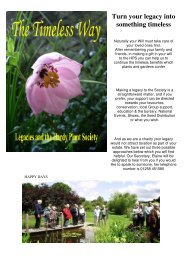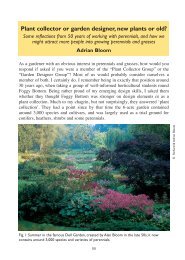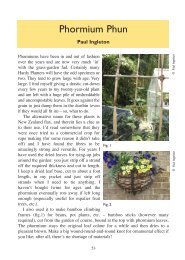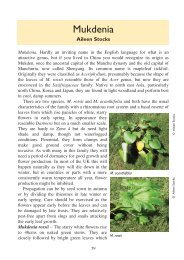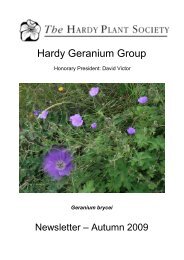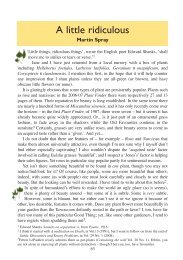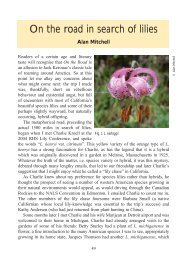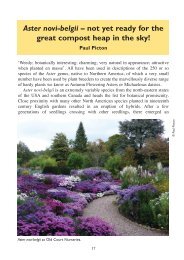The pleasure and pain of an open garden - Hardy Plant Society
The pleasure and pain of an open garden - Hardy Plant Society
The pleasure and pain of an open garden - Hardy Plant Society
Create successful ePaper yourself
Turn your PDF publications into a flip-book with our unique Google optimized e-Paper software.
<strong>The</strong> <strong>pleasure</strong> <strong><strong>an</strong>d</strong> the <strong>pain</strong> <strong>of</strong> <strong>an</strong> <strong>open</strong> <strong>garden</strong><br />
Gill Heavens<br />
‘<strong>The</strong>re is no gathering the rose without being pricked by the thorns’ 1<br />
© Gill Heavens<br />
1<br />
Cliffe Garden, as the name accurately suggests, clings optimistically to the<br />
northern coast <strong>of</strong> Devon in the village <strong>of</strong> Lee, near Ilfracombe. It comprises 5<br />
acres <strong>of</strong> mixed formal <strong>garden</strong> <strong><strong>an</strong>d</strong> woodl<strong><strong>an</strong>d</strong>, much <strong>of</strong> which was laboriously<br />
carved out in the 1920s from a field adjacent to Cliffe House (fig. 1). Privately<br />
owned, the <strong>garden</strong> is <strong>open</strong>ed for charity under the National Gardens Scheme<br />
between 1 April (signific<strong>an</strong>t, I sometimes think) <strong><strong>an</strong>d</strong> 30 September every year.<br />
This has proved to be both a <strong>pleasure</strong> <strong><strong>an</strong>d</strong> <strong>an</strong> occasional <strong>pain</strong>, <strong><strong>an</strong>d</strong> I will try to<br />
convey some <strong>of</strong> the challenges involved when on show for 6 months <strong>of</strong> every year.<br />
We attract a wide variety <strong>of</strong> visitors: the NGS-ers, armed with Yellow Books<br />
<strong><strong>an</strong>d</strong> experience <strong>of</strong> m<strong>an</strong>y <strong>garden</strong>s; the holidaymakers on day visits or staying in<br />
one <strong>of</strong> Lee’s holiday homes; the walkers on the coast path side-tracked en route to<br />
Mortehoe; the coach trippers deposited in the bay with <strong>an</strong> hour on their h<strong><strong>an</strong>d</strong>s; the<br />
horticulturally knowledgeable; the lost; <strong><strong>an</strong>d</strong> the bewildered. All are equally<br />
welcome. This diversity <strong>of</strong> hum<strong>an</strong>kind presents us with our challenge which is,<br />
quite simply, to try to please everyone all <strong>of</strong> the time. Perhaps I should rephrase<br />
that: <strong>of</strong> course this is not the slightest bit simple, but still the aim remains.<br />
1<br />
<strong>The</strong> Two Travellers, Fables <strong>of</strong> Bidpai<br />
10
© Gill Heavens<br />
© Gill Heavens<br />
2 3<br />
So let’s look at some different breeds <strong>of</strong> <strong>garden</strong> visitor <strong><strong>an</strong>d</strong> attempt to explain how<br />
we try to ‘please all’:<br />
1. <strong>The</strong> Pl<strong>an</strong>t Hunters We try to label all pl<strong>an</strong>ts with accurate Latin names,<br />
sometimes easier said th<strong>an</strong> done, contending with wrongly named purchases <strong><strong>an</strong>d</strong><br />
the bot<strong>an</strong>ists ch<strong>an</strong>ging their minds every 5 minutes. In my own experience <strong>of</strong><br />
visiting <strong>garden</strong>s it c<strong>an</strong> be frustrating when the one pl<strong>an</strong>t you are desperate to<br />
identify isn’t labelled. I must confess that labels are also imperative on those<br />
frequent occasions when you are asked a specific pl<strong>an</strong>t name <strong><strong>an</strong>d</strong> the brain<br />
inst<strong>an</strong>tly turns to mush. Our other visitors (the wildlife <strong>of</strong> Cliffe) seem to enjoy<br />
moving labels around the <strong>garden</strong>, <strong><strong>an</strong>d</strong> labels are also vulnerable to the unruly boot<br />
<strong>of</strong> a <strong>garden</strong>er or over-enthusiastic weeding. Hopefully there are plenty <strong>of</strong><br />
interesting pl<strong>an</strong>ts to keep the experts happily searching for the more unusual<br />
specimens throughout the <strong>garden</strong><br />
including C<strong>an</strong>tua buxifolia,<br />
Pseudop<strong>an</strong>ax lessonii “Gold<br />
Splash” (fig. 2) <strong><strong>an</strong>d</strong> Stylophorum<br />
lasiocarpum.<br />
2. <strong>The</strong> Traditionalists It was a<br />
<strong>pleasure</strong> last summer to meet a<br />
couple who told me <strong>of</strong> their<br />
struggle to maintain a traditional<br />
‘English’ <strong>garden</strong> in Tasm<strong>an</strong>ia.<br />
Especially ironic as we battle<br />
on with various Tasm<strong>an</strong>i<strong>an</strong><br />
4<br />
pl<strong>an</strong>ts here, including Correa<br />
© Gill Heavens<br />
11
© Gill Heavens<br />
© Gill Heavens<br />
backhouse<strong>an</strong>a, Sol<strong>an</strong>um laciniatum <strong><strong>an</strong>d</strong> Leptospermum gr<strong><strong>an</strong>d</strong>iflorum. <strong>The</strong>y<br />
admired the rose beds <strong>of</strong> ‘Fragr<strong>an</strong>t Cloud’ <strong><strong>an</strong>d</strong> ‘Silver Wedding’ <strong><strong>an</strong>d</strong> the<br />
herbaceous borders which their dry climate makes so difficult to maintain. Early in<br />
the season m<strong>an</strong>y large established camellias <strong><strong>an</strong>d</strong> b<strong>an</strong>ks <strong>of</strong> narcissus herald the<br />
spring, whilst late in the season the m<strong>an</strong>y varieties <strong>of</strong> fuchsia flower well into the<br />
winter months (fig. 3).<br />
3. <strong>The</strong> Artists <strong>The</strong>se are the<br />
lovers <strong>of</strong> colour <strong><strong>an</strong>d</strong> form.<br />
Colour is <strong>an</strong> import<strong>an</strong>t<br />
element in the <strong>garden</strong> <strong><strong>an</strong>d</strong><br />
quite simply the more the<br />
merrier (fig. 4); there is no<br />
consulting colour wheels,<br />
RHS charts or even careful<br />
consideration. Our combinations<br />
are mainly down to instinct, a<br />
little daring <strong><strong>an</strong>d</strong> very <strong>of</strong>ten<br />
5<br />
happy coincidence. Of course<br />
on this subject no one c<strong>an</strong> be<br />
right or wrong: some love the pastel shades, some the hot colours, some the<br />
Barbie pinks, some the cool whites, whether it be flower or foliage. <strong>The</strong><br />
herbaceous borders run through the spectrum from violet through to red (with<br />
white as <strong>an</strong> added bonus) pl<strong>an</strong>ted in homage to Gertrude Jekyll. For those fond <strong>of</strong><br />
the monochrome, the mature Magnolia x soul<strong>an</strong>ge<strong>an</strong>a ‘Lennei Alba’ (fig. 5) is the<br />
centrepiece <strong>of</strong> the Black <strong><strong>an</strong>d</strong> White Border. Form <strong>of</strong> course is also vital, from the<br />
dramatic Furcraea longaeva, hedychiums <strong><strong>an</strong>d</strong> Meli<strong>an</strong>thus major, through the<br />
eleg<strong>an</strong>t Misc<strong>an</strong>thus <strong><strong>an</strong>d</strong> Lysimachia clethroides to the small but perfectly formed<br />
Fuchsia thymifolia, <strong><strong>an</strong>d</strong> Taxus baccata ‘Pygmaea’<br />
(fig. 6), all <strong>of</strong> which add depth <strong>of</strong> interest to the<br />
<strong>garden</strong>.<br />
4. <strong>The</strong> Children Few children visit the <strong>garden</strong>, most<br />
would prefer to be rock-pooling in the bay below.<br />
However, with a bit <strong>of</strong> imagination there are as m<strong>an</strong>y<br />
treasures to find in the <strong>garden</strong> as under a wet rock<br />
<strong><strong>an</strong>d</strong> certainly less slimy! <strong>The</strong>re are things to touch -<br />
the wonderfully tactile Salvia fulgens <strong><strong>an</strong>d</strong> Stachys<br />
coccinea – <strong><strong>an</strong>d</strong> those to avoid touching – most<br />
notably our large Agave americ<strong>an</strong>a (fig. 7 ). Lots <strong>of</strong><br />
6<br />
interesting scents including lavender <strong><strong>an</strong>d</strong> roses, <strong><strong>an</strong>d</strong><br />
12
for a little sadistic fun Vestia<br />
foetida. Arisarum proboscideum is<br />
always a winner when, in flower,<br />
its mouse tails poke out from the<br />
foliage. What better playground<br />
th<strong>an</strong> the woodl<strong><strong>an</strong>d</strong>, perfect for<br />
exploring <strong><strong>an</strong>d</strong> searching for pine<br />
cones from one <strong>of</strong> our mature<br />
Monterey Pines.<br />
5. <strong>The</strong> Technicals M<strong>an</strong>y visitors<br />
are interested in the mech<strong>an</strong>ics <strong>of</strong><br />
7<br />
the <strong>garden</strong>, how it all works on a<br />
day-to-day basis. We are fervent<br />
composters; designated areas c<strong>an</strong> be seen throughout the <strong>garden</strong> both for general<br />
<strong>garden</strong> waste <strong><strong>an</strong>d</strong> leaf mould, <strong><strong>an</strong>d</strong> we utilise seaweed as a precious free resource.<br />
Our beloved shredding machine provides us with mulches, reducing weeds <strong><strong>an</strong>d</strong><br />
eventually adding org<strong>an</strong>ic matter to the soil. Propagation in all its forms is <strong>an</strong><br />
invaluable <strong><strong>an</strong>d</strong> cost-effective way <strong>of</strong> stocking the <strong>garden</strong>, r<strong>an</strong>ging from seed<br />
sowing (m<strong>an</strong>y from HPS <strong><strong>an</strong>d</strong> RHS seed schemes) to cuttings <strong><strong>an</strong>d</strong> divisions. We<br />
also benefit greatly from pl<strong>an</strong>t swaps with friends <strong><strong>an</strong>d</strong> neighbours.<br />
6. <strong>The</strong> Naturalists Although there are m<strong>an</strong>y formal <strong><strong>an</strong>d</strong> ‘hard’ aspects to the<br />
<strong>garden</strong>, such as lawns, stone terracing <strong><strong>an</strong>d</strong> gravel paths, we try to bal<strong>an</strong>ce this<br />
with a relaxed form <strong>of</strong> pl<strong>an</strong>ting. Minimal staking (perhaps too minimal<br />
sometimes) allows pl<strong>an</strong>ts to flop foppishly over paths <strong><strong>an</strong>d</strong> t<strong>an</strong>gle through each<br />
other. Ger<strong>an</strong>ium pyrenaicum ‘Bill Wallis’ scrambling through Fuchsia<br />
glaziovi<strong>an</strong>a works very well, as do self-seeded yellow nasturtiums running<br />
through Teucrium hirc<strong>an</strong>icum.<br />
This makes for <strong>an</strong> interesting<br />
unt<strong>an</strong>gling come the autumn <strong><strong>an</strong>d</strong><br />
also unfortunately leads to some<br />
casualties not quite able to hold<br />
their own. We do not expect our<br />
pl<strong>an</strong>ts to st<strong><strong>an</strong>d</strong> to attention <strong><strong>an</strong>d</strong><br />
they are not expected to<br />
be flawless but, we hope,<br />
give the impression <strong>of</strong> unrestrained<br />
abund<strong>an</strong>ce (fig. 8). <strong>The</strong><br />
woodl<strong><strong>an</strong>d</strong> paths zigzag <strong><strong>an</strong>d</strong> curl<br />
8<br />
org<strong>an</strong>ically upwards (fig. 9) <strong><strong>an</strong>d</strong> are<br />
© Gill Heavens<br />
© Gill Heavens<br />
13
© Gill Heavens<br />
© Gill Heavens<br />
lined with shade lovers such<br />
as Drimys winteri, camellias,<br />
Enki<strong>an</strong>thus, <strong><strong>an</strong>d</strong> our new star<br />
Trochodendron aralioides.<br />
7. <strong>The</strong> Perfectionists All I c<strong>an</strong><br />
say is they will be sorely<br />
disappointed <strong><strong>an</strong>d</strong> quote George<br />
Orwell – ‘<strong>The</strong> essence <strong>of</strong> being<br />
hum<strong>an</strong> is that one does not seek<br />
perfection’.<br />
9<br />
Of course meeting people is one<br />
<strong>of</strong> the benefits <strong>of</strong> <strong>open</strong>ing the<br />
<strong>garden</strong> <strong><strong>an</strong>d</strong> we have met m<strong>an</strong>y fascinating <strong><strong>an</strong>d</strong> intriguing people. <strong>The</strong>y have<br />
travelled from around the world, the country <strong><strong>an</strong>d</strong> even the county. Highlights this<br />
year included <strong>an</strong> extremely elderly couple who vali<strong>an</strong>tly walked up the very steep<br />
hill <strong><strong>an</strong>d</strong> fearlessly insisted on walking the whole <strong>of</strong> the <strong>garden</strong>. <strong>The</strong> South Afric<strong>an</strong><br />
m<strong>an</strong> <strong><strong>an</strong>d</strong> his party who passionately pointed out pl<strong>an</strong>ts to me that grew wild in his<br />
homel<strong><strong>an</strong>d</strong> such as the watsonias <strong><strong>an</strong>d</strong> schizostylis whilst I enviously dr<strong>an</strong>k in every<br />
word. <strong>The</strong> retired gentlem<strong>an</strong> who called in to say he had, as <strong>an</strong> apprentice, m<strong>an</strong>y<br />
decades previously <strong>pain</strong>ted the wrought-iron gates. <strong>The</strong> newly engaged Americ<strong>an</strong><br />
couple, so full <strong>of</strong> fun <strong><strong>an</strong>d</strong> enthusiasm, who w<strong>an</strong>ted to get married on the lawn<br />
they loved the <strong>garden</strong> so much. <strong>The</strong> two young girls who told me they hadn’t<br />
w<strong>an</strong>ted to visit the <strong>garden</strong> but were really pleased that they had, “It was fun!”<br />
And the m<strong>an</strong> who told me he really loved the “wild bit over there” – which<br />
reminded me the Bay Tree Bed needed weeding!<br />
<strong>The</strong>re are several themes <strong>of</strong> conversation in the <strong>garden</strong> which seem to be<br />
repeated on a regular basis, these include:<br />
<strong>The</strong> Weather “Of course you<br />
are very lucky here with the<br />
weather.” True we are excused<br />
most frosts but like everyone we<br />
suffered in last year’s severe<br />
winter (fig. 10). As we are north<br />
facing the winter sun doesn’t<br />
rise high enough to escape the<br />
hill to the south <strong><strong>an</strong>d</strong> from mid-<br />
November to mid-February no<br />
10<br />
sun touches the <strong>garden</strong>. Any<br />
frost stays frost for a long time<br />
14
© Gill Heavens<br />
© Gill Heavens<br />
11 12<br />
with no sun to thaw it. We also suffer from especially spiteful, salt-laden northerly<br />
winds which rush round the <strong>garden</strong> burning all but the toughest <strong>of</strong> leaves.<br />
Well-drained Well you’d certainly think so looking at the <strong>garden</strong>. However<br />
the combination <strong>of</strong> <strong>an</strong> average <strong>an</strong>nual rainfall <strong>of</strong> 100cm <strong><strong>an</strong>d</strong> no winter sun, added<br />
to the underground spring water <strong><strong>an</strong>d</strong> the easily compacted, silty soil me<strong>an</strong>s mud<br />
pies for a large proportion <strong>of</strong> the year. We <strong>garden</strong>ers <strong>of</strong>ten need treatment for a<br />
severe case <strong>of</strong> rising damp.<br />
<strong>The</strong> Slope By necessity <strong>of</strong> the site, slope is always going to be <strong>an</strong> issue. In fact<br />
the slope adds a welcome extra dimension to the <strong>garden</strong>: pl<strong>an</strong>ts c<strong>an</strong> be looked at<br />
from above, below, as well as the usual straight-on. <strong>The</strong> designers <strong>of</strong> the <strong>garden</strong><br />
in their wisdom, however, put r<strong><strong>an</strong>d</strong>om steps just where you wouldn’t expect or<br />
w<strong>an</strong>t them. Down one step, up two, down one – is it me, but doesn’t that even up?<br />
True, aesthetically it works, but with a full wheelbarrow to hoik up <strong><strong>an</strong>d</strong> bounce<br />
down it’s not quite so attractive.<br />
Architectural Walls Again true, the traditionally built walls are beautiful (fig. 11)<br />
<strong><strong>an</strong>d</strong> a great asset to the <strong>garden</strong> but when you frequently have to scrape mind-yourown-business<br />
(Soleirolia soleirolii), from between the stones you c<strong>an</strong> see the<br />
adv<strong>an</strong>tage <strong>of</strong> breeze blocks (only joking). <strong>The</strong>y also serve as wonderful slug/snail<br />
hotels, although this is nothing that a good sharp poking stick c<strong>an</strong>’t cure (fig. 12).<br />
Wildlife We are blessed with much wildlife, which c<strong>an</strong> be a mixed blessing.<br />
From the state <strong>of</strong> the <strong>garden</strong> some mornings it is obvious our nocturnal visitors<br />
are real ‘party people’. <strong>The</strong> lawn has been dug up in a badger-feeding frenzy.<br />
Foxes mark their territory in a most basic way. Deer frolic <strong><strong>an</strong>d</strong> feast in the<br />
borders. Moles run riot <strong><strong>an</strong>d</strong> don’t get me on to the voles. <strong>The</strong> blackbirds throw the<br />
mulch everywhere <strong><strong>an</strong>d</strong> if I find out who has dug that large hole in the newly<br />
m<strong>an</strong>ured rose bed… But all is inst<strong>an</strong>tly forgiven when catching sight <strong>of</strong> a dolphin<br />
in the bay, a peregrine falcon overhead, or even a glimpse <strong>of</strong> those pesky deer.<br />
<strong>The</strong>n before we know it the end <strong>of</strong> September arrives, the signs are taken<br />
down, ropes removed <strong><strong>an</strong>d</strong> corsets loosened. Feeling how a supermodel must feel<br />
when she walks in her front door, slips on her furry slippers <strong><strong>an</strong>d</strong> baggy tracksuit<br />
bottoms, out <strong>of</strong> sight <strong>of</strong> the paparazzi, we c<strong>an</strong> relax a little. <strong>The</strong> carpet is lifted<br />
15
© Gill Heavens<br />
© Gill Heavens<br />
<strong><strong>an</strong>d</strong> all the rubbish swept<br />
underneath in the previous<br />
months removed, the backs <strong>of</strong><br />
borders weeded, pl<strong>an</strong>ts cut<br />
back, tools left out at break<br />
times, songs c<strong>an</strong> be sung with<br />
gusto <strong><strong>an</strong>d</strong> the occasional<br />
cartwheel performed on the<br />
lawn. <strong>The</strong> dewy spring <strong><strong>an</strong>d</strong><br />
autumn mornings are beautiful<br />
<strong><strong>an</strong>d</strong> peace encapsulated (fig.<br />
13<br />
13). <strong>The</strong>re is, however, along<br />
with the sense <strong>of</strong> relief, a<br />
glimmer <strong>of</strong> regret <strong><strong>an</strong>d</strong> “perhaps<br />
one more week next year”.<br />
Opening the <strong>garden</strong> is<br />
definitely worth it for the<br />
interesting people met during the<br />
season. Those who tender good<br />
advice, share woes <strong><strong>an</strong>d</strong> joys, who<br />
say, “You’ve made my day”, in<br />
essence who speak the same<br />
l<strong>an</strong>guage. Unfortunately there is<br />
14<br />
the occasional person who<br />
doesn’t ‘get it’, those who race<br />
around at breakneck speed, not looking but expecting to be entertained without <strong>an</strong>y<br />
effort put in by themselves. As in all walks <strong>of</strong> life, there will always be those who<br />
see the weeds <strong><strong>an</strong>d</strong> those who see the flowers. This is not Disneyl<strong><strong>an</strong>d</strong>: with limited<br />
resources we try to maintain <strong>an</strong> interesting, aesthetically pleasing plot which luckily<br />
for us is located in a beautiful part <strong>of</strong> the world. <strong>The</strong> odd wart inevitably pops up<br />
from time to time <strong><strong>an</strong>d</strong> we do our best to deal with it. Ultimately we have to please<br />
ourselves, that is the owners <strong><strong>an</strong>d</strong> the <strong>garden</strong>ers, <strong><strong>an</strong>d</strong>, if <strong>an</strong>yone else gets <strong>pleasure</strong>,<br />
then all the better.<br />
And that brings us back to the question: c<strong>an</strong> we please all <strong>of</strong> the people all <strong>of</strong><br />
the time? Well, what do you think!<br />
And <strong>of</strong> course if all else fails there is always the view (fig. 14).<br />
Gill Heavens trained at C<strong>an</strong>nington College, Somerset. Three years ago<br />
she swapped city <strong>garden</strong>ing in Bristol for coastal <strong>garden</strong>ing as head<br />
<strong>garden</strong>er at Cliffe, North Devon.<br />
16



